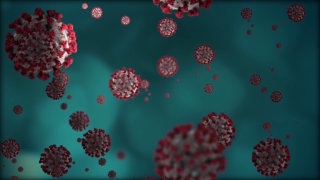
UC San Diego School of Medicine researchers announced Tuesday they have discovered a carbohydrate that the SARS-CoV-2 virus uses to latch onto a cellular molecule in the lungs, which has potential implications for treatment of COVID-19 patients.
Since January, researchers have known that the novel coronavirus primarily uses a molecule known as ACE2 -- which sits like a doorknob on the outer surfaces of the cells that line the lungs -- to enter and infect those cells. Finding a way to lock out that interaction between virus and doorknob as a means to treat the infection has become the goal of many research studies.
The UCSD researchers recently discovered the virus cannot grab onto that ACE2 doorknob without a carbohydrate heparan sulfate, which is also found on lung cell surfaces.
"ACE2 is only part of the story," said Jeffrey Esko, a professor of cellular and molecular medicine at UCSD and co-director of the Glycobiology Research and Training Center. "It isn't the whole picture."
Esko's study, published in the academic journal Cell, introduces a potential new approach for preventing and treating COVID-19.
His team demonstrated two approaches that can reduce the ability of the virus to infect human cells cultured in the lab by about 80% to 90%, either removing heparan sulfate with enzymes or using heparin as bait to lure and bind the coronavirus away from human cells.
Heparin, a form of heparan sulfate, is already a widely used medication to prevent and treat blood clots.
Local
Esko's team has long studied heparan sulfate and the role it plays in health and disease.
The team discovered that the virus binds to heparin. When heparin is bound, the virus is able to bind to ACE2. The virus, the researchers found, must bind both heparan sulfate on the cell surface and ACE2 in order to get inside human lung cells grown in a laboratory dish.
With this viral entry mechanism established, the researchers next set about trying to disrupt it. They found that enzymes that remove heparan sulfate from cell surfaces prevent SARS-CoV-2 from gaining entry into cells. Likewise, treatment with heparin also blocked infection. The heparin treatment worked as an anti-viral at doses currently given to patients, even when the researchers removed the anticoagulant region of the protein -- the part responsible for preventing blood clots.
Esko cautioned that the findings are still far from translating into a COVID-19 treatment for people. Researchers will need to test heparin and heparan sulfate inhibitors in animal models of SARS-CoV-2 infection. In a related study, UC San Diego scientists are also exploring the role human microbiomes, including the bacteria that live in and on the body, play in altering heparan sulfate and thus influencing a person's susceptibility to COVID-19.
"This is one of the most exciting periods of my career -- all of the things we've learned about heparan sulfate and the resources we've developed over the years have come together with a variety of experts across multiple institutions who were quick to collaborate and share ideas," Esko said.



